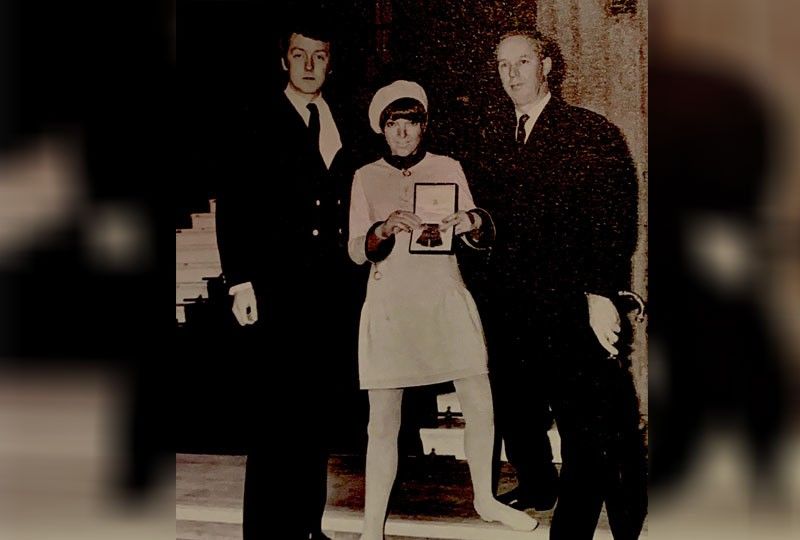Revisiting Mary Quant, The designer who challenged Paris and made fashion fun

Ayoung Brit presenting her collection in Paris, the center of fashion and couture, in 1963? Quite preposterous, as the Brits themselves would say. The French program for the show at Hotel Crillon, in fact, said “it was perhaps presumptuous to present young British fashion in France,” but had to concede that “the talent of Mary Quant was undeniable.”
Mary Quant indeed challenged, not just the dominance of French couture, but the whole fashion system and the way women dressed. This was a time when women would be turned away from fine dining restaurants if they were wearing trousers and they had to follow certain codes that basically made them dress like their mothers. Quant changed all that, revolutionizing fashion with energy, flair and rebellion and making British street style the global influence it remains today.
To celebrate this British icon who is an OBE (Officer of the Order of the British Empire) awardee, the Victoria & Albert in London is presenting the first international retrospective on her work from 1955 to 1975. Whereas most exhibits emphasize couture, “this is very different as there’s a huge focus on the women who wore these designs,” according to Stephanie Wood, who co-curated the exhibit with Jenny Lister. To achieve this, the V&A tracked down rare Quant pieces from the public with a call out #WeWantQuant campaign that received more than 1,000 responses from friends of Quant and members of her bohemian circle but mostly from ordinary women like students and nurses who lived from as far away as Australia and San Francisco. One lady even brought her Quant dress to Antarctica to wear at the South Pole. In the end, although there was only space for the offerings of 30 women, these add an interesting dimension to the more than 200 pieces on show including the V&A holdings which comprise the largest collection of Quant garments in the world as well as the designer’s personal archive and important international loans.
The exhibition begins with the post-war years of London when Mary Quant opened her experimental shop Bazaar together with her husband Alexander Plunket Greene and photographer Archie McNair on Chelsea’s King’s Road in 1955. Although she initially created a “bouillabaisse” of quirky clothes and accessories from art schools and other brands, her frustration with the drab post-rationing fashions led her to make clothes of her own groundbreaking designs. But it was not just the clothes that were revolutionary. Compared to nearby Chelsea shops, her window displays were unusual and verged on the surreal, like a photographer suspended upside down while capturing a mannequin with a flashbulb or a model with a real lobster on a leash. With lively music and cocktails, she transformed the formal experience of shopping.
With this seismic shift, Quant declared: “Snobbery has gone out of fashion. In our shops, you will find duchesses jostling with typists to buy the same dress.” Bazaar became a permanently running cocktail party, open till late at night and attracting Chelsea’s beau monde of socialites, artists and Youthquake beauties. Buying a dress from Quant became a new rite of passage for the elite as aristocratic customs like “deb of the year” and court presentations became démodé.
“They reflected the sense of freedom that we felt at the time – shorter skirts allowed mobility, to run, jump and to have fun in — providing fashion for everyone who enjoyed the styling and the crazy accessories,” says Quant. Her clothes demonstrated that change was coming, expressing how women’s lives were veering away from traditional stereotypes. “Her clothes provided a language to express the empowerment of women at a time when words like sexism had barely been invented,” according to Lister.
Although there is controversy on whether it was Courrèges or Quant who invented the mini skirt, Quant definitely made it vastly popular — putting the mini as well as hot pants on the streets, sparking a new creative scene in London and beyond. Aside from raising the hemline, she subverted gender norms by transforming gentlemen’s suiting fabrics into fun and relaxed garments. Trousers which were usually worn at home and were banned in formal events, became a staple for the Quant woman, to be worn as one pleases. She also radically used materials like PVC which she used for her bright, wet-look collection which was a runaway hit; terrycloth and velour for loungewear and body suits; and jersey which was versatile for the active lifestyle — perfect for the 60s minis and modernist silhouettes and the 70s clingy and swingy looks.
Jersey was also efficient — requiring less precise fitting, leading to quicker production which made her clothes more affordable for more women. By 1963, Mary Quant established the Ginger Group collection to become a wholesale brand available in 75 outlets across the UK and later available in the US and by 1966 she expanded her brand further to include cosmetics, eventually extending to home furnishings, underwear, hosiery, jewellery and even Daisy doll toys, all of which she exported around the world. Ahead of her time in marketing and promotion, her daisy logo became an easily recognizable symbol for the optimistic, liberated style she embodied.
One of the reasons why her brand was so strong was that she did a lot of the modelling herself like Coco Chanel and Elsa Schiaparelli before her, both of whom were inspirations. It was also a total look, even collaborating with Vidal Sassoon for the geometric, five-point haircut which was not only perfect for her dresses but liberated women from rollers and hairdryers.
There was also something about her child-like innocence that appealed to the women of that era: Keeping her upper half demure with Peter Pan collars, roll necks and zip-ups instead of exposing cleavages, it’s all leg and attitude and teasing hemlines with a playful, gamine quality that spelled freedom. Bare legs weren’t even exposed with her introduction of bright colored tights. “She did not want to grow up,” says Lister, “the clothes wanted to keep childhood going but that became a new kind of sexiness, defined by her.”
Despite her success, Quant insists that they didn’t realize that what they were creating was pioneering: “We were simply busy relishing all the opportunities and embracing all the results before rushing on to the next challenge!”
But her son, Orlando believes that his mother’s designs were more important than her modest account of them: “They brought an attitude revolution that changed much more than fashion.”
* * *
“Mary Quant” is ongoing at the V&A in London. Visit www.vam.ac.uk for details. Follow the authors on Instagram @rickytchitov; Twitter @RickyToledo23; Facebook - Ricky Toledo Chito Vijandre.



















